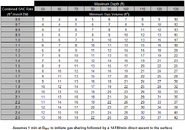When you are freaked out at the surface as a new diver on your 6th opena water dive... you don't remeber to dump your weights or orally inflate your BC... especially if your BC is an airtrim model and requires more steps.
But you would if it was driven into you. In the pool, many many ascent are made and then completed with an oral inflation to achieve neutral buoyancy. No Student of mine is certified without Mastering this skill to a level that is beyond expected. Oral inflation both under water and at the surface should be a regularly practiced skill and especially important if you rent gear or change gear as you may have differences you don't want to discover in an emergency.





